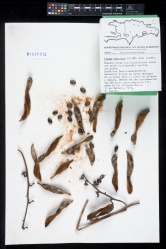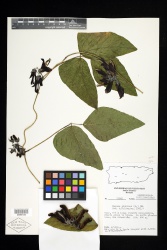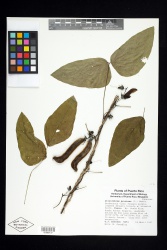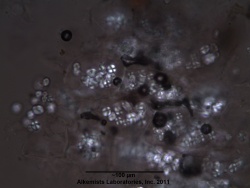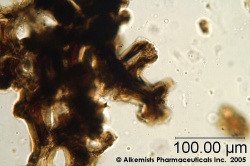Mucuna pruriens (seed)
(add voucher specimen) |
(add HPTLC literature reference) |
||
| Line 57: | Line 57: | ||
=Supplementary Information= | =Supplementary Information= | ||
| + | ==Other Publications== | ||
| + | ===HPTLC L-Dopa Estimation, Modi, ''et al.'', 2008=== | ||
| + | '''Estimation of L-Dopa from Mucuna pruriens LINN and Formulations Containing M. pruriens by HPTLC Method,''' | ||
| + | <blockquote>'''Abstract.''' | ||
| + | |||
| + | A selective, precise, and accurate high-performance thin-layer chromatographic (HPTLC) method has been developed for the analysis of L-dopa in Mucuna pruriens seed extract and its formulations. The method involves densitometric evaluation of L-dopa after resolving it by HPTLC on silica gel plates with n-butanol–acetic acid–water (4.0+1.0+1.0, v/v) as the mobile phase. Densitometric analysis of L-dopa was carried out in the absorbance mode at 280 nm. The relationship between the concentration of L-dopa and corresponding peak areas was found to be linear in the range of 100 to 1200 ng/spot. The method was validated for precision (inter and intraday), repeatability, and accuracy. Mean recovery was 100.30%. The relative standard deviation (RSD) values of the precision were found to be in the range 0.64—1.52%. In conclusion, the proposed TLC method was found to be precise, specific and accurate and can be used for identification and quantitative determination of L-dopa in herbal extract and its formulations.<ref> | ||
| + | Modi, K.P., Patel, N.M., Goyal, R.K. 2008. Estimation of L-Dopa from Mucuna pruriens LINN and Formulations Containing M. pruriens by HPTLC Method ''Chemical and Pharmaceutical Bulletin'' 56(3), 357-359. http://doi.org/10.1248/cpb.56.357</ref></blockquote> | ||
| + | |||
=Sources= | =Sources= | ||
<references /> | <references /> | ||
Revision as of 16:49, 12 April 2016
Contents |
Nomenclature
Mucuna pruriens (L.) DC. Fabaceae
Standardized common name (English): velvet bean
Ayurvedic name(s): atmagupta; kapikacchu
Botanical Voucher Specimen
|
|
|
|
Organoleptic Characteristics
Macroscopic Characteristics
|
Microscopic Characteristics
 |
 |
|
|
|
High Performance Thin Layer Chromatographic Identification
Supplementary Information
Other Publications
HPTLC L-Dopa Estimation, Modi, et al., 2008
Estimation of L-Dopa from Mucuna pruriens LINN and Formulations Containing M. pruriens by HPTLC Method,
Abstract. A selective, precise, and accurate high-performance thin-layer chromatographic (HPTLC) method has been developed for the analysis of L-dopa in Mucuna pruriens seed extract and its formulations. The method involves densitometric evaluation of L-dopa after resolving it by HPTLC on silica gel plates with n-butanol–acetic acid–water (4.0+1.0+1.0, v/v) as the mobile phase. Densitometric analysis of L-dopa was carried out in the absorbance mode at 280 nm. The relationship between the concentration of L-dopa and corresponding peak areas was found to be linear in the range of 100 to 1200 ng/spot. The method was validated for precision (inter and intraday), repeatability, and accuracy. Mean recovery was 100.30%. The relative standard deviation (RSD) values of the precision were found to be in the range 0.64—1.52%. In conclusion, the proposed TLC method was found to be precise, specific and accurate and can be used for identification and quantitative determination of L-dopa in herbal extract and its formulations.[7]
Sources
- ↑ Images courtesy of the C.V. Starr Virtual Herbarium of the New York Botanical Garden http://sciweb.nybg.org/science2/VirtualHerbarium.asp
- ↑ Images courtesy of the C.V. Starr Virtual Herbarium of the New York Botanical Garden http://sciweb.nybg.org/science2/VirtualHerbarium.asp
- ↑ Images courtesy of the C.V. Starr Virtual Herbarium of the New York Botanical Garden http://sciweb.nybg.org/science2/VirtualHerbarium.asp
- ↑ United States Dispensatory (1918)
- ↑ Elan M. Sudberg, Alkemist Laboratories http://www.alkemist.com
- ↑ Elan M. Sudberg, Alkemist Laboratories http://www.alkemist.com
- ↑ Modi, K.P., Patel, N.M., Goyal, R.K. 2008. Estimation of L-Dopa from Mucuna pruriens LINN and Formulations Containing M. pruriens by HPTLC Method Chemical and Pharmaceutical Bulletin 56(3), 357-359. http://doi.org/10.1248/cpb.56.357
